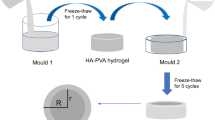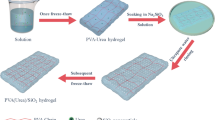Abstract
Nanohydroxyapatite reinforced poly(vinyl alcohol) gel (nano-HA/PVA gel) composites has been proposed as a promising biomaterial, especially used as an articular cartilage repair biomaterial. In this paper, nano-HA/PVA gel composites were prepared from mixing nano-HA particles modified by silicon coupling agent, with physiological saline solution (PSS) of PVA by freezing-thawing method. The effects of various factors on the mechanical properties of nano-HA/PVA gel composites were evaluated. It was shown that the mechanical behavior of nano-HA/PVA gel composites was similar to that of natural articular cartilage, which held special viscoelastic characteristics. The tensile strength and tensile modulus of the composites improved correspondingly with the increase of freezing-thawing times and concentration of PVA solution. The more concentration of PVA solution, the higher influence degree of concentration on the tensile strength of composites is. The tensile strength and tensile modulus of nano-HA/PVA hydrogel composites increased first and then decreased with the rising nano-HA content of the composites. The tensile modulus of the composites improved remarkably with the increase of elongation ratio.









Similar content being viewed by others
References
Kobayashi M, Chang YS, Oka M (2005) Biomaterials 26:3243
Noguchi T, Yamamuro T, Oka M (1991) Appl Biomater 2(2):101
Covert RJ, Ott RD, Ku DN (2003) Wear 255:1064
Sawae Y, Murakari T (1996) Trans JSME Part C 62:2343
Suciu AN, Iwatsubo T, Matsuda M (2004) JSME Part C 47(1):199
Zheng QG, Jiu MX, Xiang HZ (1998) Biomed Mater Eng 8(1):75
Stammen JA, Williams S, Ku DN (2001) Biomaterials 22:799
Huang HY, Liu ZH, Tao F (1997) Clin Neurol Neurosurg 99:20
Ahn ES, Gleason NJ, Nakahira A (2001) Nano Lett 1(3):149
Zheng YD, Wang YJ, Chen XF et al (2005) Chem J Chinese Univ 26(9):1735
Liu Q, Joost RW, Clemens AB (1997) Biomaterials 18:1263
Muta H (2001) Mol Struct (Theochem) 536:219
Rosa R, Finizia A, Claudio DR (2004) Macromolecules 37:1921
Nebahat D, Dilhan MK, Elvan B (2006) Colloids Surf B Biointerfaces 48:42
Acknowledgements
Research is supported by the national natural science foundation of China and by the national high technology research and development program of China.
Author information
Authors and Affiliations
Corresponding author
Rights and permissions
About this article
Cite this article
Yusong, P., Dangsheng, X. & Xiaolin, C. Mechanical properties of nanohydroxyapatite reinforced poly(vinyl alcohol) gel composites as biomaterial. J Mater Sci 42, 5129–5134 (2007). https://doi.org/10.1007/s10853-006-1264-4
Received:
Accepted:
Published:
Issue Date:
DOI: https://doi.org/10.1007/s10853-006-1264-4




